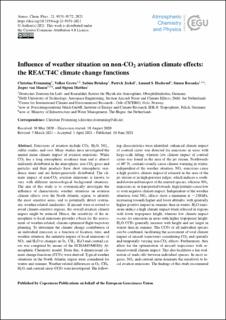| dc.description.abstract | Emissions of aviation include CO2, H2O, NOx, sulfur oxides, and soot. Many studies have investigated the annual mean climate impact of aviation emissions. While CO2 has a long atmospheric residence time and is almost uniformly distributed in the atmosphere, non-CO2 gases and particles and their products have short atmospheric residence times and are heterogeneously distributed. The climate impact of non-CO2 aviation emissions is known to vary with different meteorological background situations. The aim of this study is to systematically investigate the influence of characteristic weather situations on aviation climate effects over the North Atlantic region, to identify the most sensitive areas, and to potentially detect systematic weather-related similarities. If aircraft were re-routed to avoid climate-sensitive regions, the overall aviation climate impact might be reduced. Hence, the sensitivity of the atmosphere to local emissions provides a basis for the assessment of weather-related, climate-optimized flight trajectory planning. To determine the climate change contribution of an individual emission as a function of location, time, and weather situation, the radiative impact of local emissions of NOx and H2O to changes in O3, CH4, H2O and contrail cirrus was computed by means of the ECHAM5/MESSy Atmospheric Chemistry model. From this, 4-dimensional climate change functions (CCFs) were derived. Typical weather situations in the North Atlantic region were considered for winter and summer. Weather-related differences in O3, CH4, H2O, and contrail cirrus CCFs were investigated. The following characteristics were identified: enhanced climate impact of contrail cirrus was detected for emissions in areas with large-scale lifting, whereas low climate impact of contrail cirrus was found in the area of the jet stream. Northwards of 60∘ N, contrails usually cause climate warming in winter, independent of the weather situation. NOx emissions cause a high positive climate impact if released in the area of the jet stream or in high-pressure ridges, which induces a south- and downward transport of the emitted species, whereas NOx emissions at, or transported towards, high latitudes cause low or even negative climate impact. Independent of the weather situation, total NOx effects show a minimum at ∼250 hPa, increasing towards higher and lower altitudes, with generally higher positive impact in summer than in winter. H2O emissions induce a high climate impact when released in regions with lower tropopause height, whereas low climate impact occurs for emissions in areas with higher tropopause height. H2O CCFs generally increase with height and are larger in winter than in summer. The CCFs of all individual species can be combined, facilitating the assessment of total climate impact of aircraft trajectories considering CO2 and spatially and temporally varying non-CO2 effects. Furthermore, they allow for the optimization of aircraft trajectories with reduced overall climate impact. This also facilitates a fair evaluation of trade-offs between individual species. In most regions, NOx and contrail cirrus dominate the sensitivity to local aviation emissions. The findings of this study recommend considering weather-related differences for flight trajectory optimization in favour of reducing total climate impact. | en_US |

